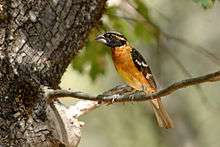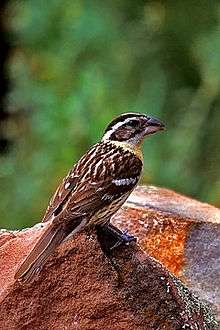Black-headed grosbeak
| Black-headed grosbeak | |
|---|---|
 | |
| Male in California, USA | |
| | |
| Scientific classification | |
| Kingdom: | Animalia |
| Phylum: | Chordata |
| Class: | Aves |
| Order: | Passeriformes |
| Family: | Cardinalidae |
| Genus: | Pheucticus |
| Species: | P. melanocephalus |
| Binomial name | |
| Pheucticus melanocephalus (Swainson, 1827) | |
| | |
The black-headed grosbeak (Pheucticus melanocephalus) is a medium-size seed-eating bird in the same family as the northern cardinal, the Cardinalidae. It is sometimes considered conspecific with the rose-breasted grosbeak (P. ludovicianus) with which it hybridises on the American Great Plains.
The 19 cm (7.5 in) long, 47 g (1.7 oz) black-headed grosbeak is a migratory bird, with nesting grounds from southwestern British Columbia, through the western half of the United States, into central Mexico. It occurs as an vagrant further south in Central America.
Description
The black-headed grosbeak's approximate length is 18–19 cm (7.1–7.5 in); it is similar in size to a common starling. As per its name, the male has a black head, and black wings and tail with prominent white patches. Its breast is dark to tawny orange in color, and its belly is yellow. The female has a brown head, neck and back with sparrow-like black streaks. She also has white streaks down the middle of her head, over her eyes and on her cheeks. Her breast is white and wings and tail are grayish-brown with two white wing bars and yellowish wing edges.
Habitat
The black-headed grosbeak prefers to live in deciduous and mixed wooded areas. It likes to be in areas where there are large trees as well as thick bushes, such as patches of broadleaved trees and shrubs within conifer forests, including streamside corridors, river bottoms, lakeshores, wetlands, and suburban areas.
Nesting
Females build nests among the dense foliage on an outer branch of tall broadleaved trees or shrubs, 3–35 ft (0.91–10.67 m) above ground. They will occasionally build in dense shrubs such as blackberry. The nest is in the shape of an open saucer, made of fine grass, rootlets twigs, bark and conifer needles. It is often lined with rootlets, hair, and fine plant material. The female lays two to five pale green, blue or gray eggs that are spotted with reddish and dark brown. The eggs are incubated by the male and female for 12–14 days. After the eggs have hatched the fledglings leave the nest in about 11 or 12 days, however they are unable to fly for another two weeks. The young are fed by both adults. The black-headed grosbeak's monogamy is under study, but pair bonds generally last for only one breeding season. They typically have one brood per season, though double broods have been documented in foothills of the Sacramento Valley in California.
Voice

The grosbeak's song is a rich warble that is similar to that of an American robin but more fluent, faster, softer, sweeter and mellow with rising and falling passages that make the song much longer than the robin's. The note is a sharp ik or eek. Both the male and female sing, but have different songs.
Diet
The black-headed grosbeak eats pine and other seeds, berries and insects, spiders and fruit. During the summer months it mostly eats spiders, snails and insects. It is one of the few birds that can safely eat the poisonous monarch butterfly. In their wintering grounds, this grosbeak consumes many monarchs and many seeds. It will come to bird feeders for sunflower and other types of seed, and fruit. Will also join Northern Orioles at feeders with grape jelly.
Range and migration
Black-headed grosbeaks range from the Pacific coast to the middle of the US Great Plains and from south western Canada to the mountains of Mexico. US and Canadian birds are highly migratory, wintering in Mexico. In the Great Plains the range of the black-headed grosbeak and the rose-breasted grosbeak overlap and have interbred somewhat. After the breeding season, they tend to seek out berry-rich areas. They migrate south early in the fall and return to the north late in the spring and have been known to do so in flocks.They also like to live in the desert in Arizona.
Behavior
Black-headed grosbeaks frequently sing from prominent perches. Both the male and female sing, but have different songs, and both are known to sing from the nest while incubating. When trying to court a female, males fly with their wings and tails spread. They forage in the foliage, on the ground or in low vegetation and are prominent berry eaters.
References
- ↑ BirdLife International (2012). "Pheucticus melanocephalus". IUCN Red List of Threatened Species. Version 2013.2. International Union for Conservation of Nature. Retrieved 26 November 2013.
- Stiles, F. Gary; Skutch, Alexander F. (1989). A Guide to the Birds of Costa Rica. Comstock Publishing Associates. ISBN 0-8014-9600-4.
- "Black-headed Grosbeak". BirdWeb.org. Seattle Audubon Society.
Further reading
- Hill, G.E. (1995). Poole, A.; Gill, F., eds. Black-headed Grosbeak (Pheucticus melanocephalus). The Birds of North America. The Academy of Natural Sciences, Philadelphia, and The American Ornithologists’ Union, Washington, D.C.
External links
| Wikimedia Commons has media related to Pheucticus melanocephalus. |
| Wikispecies has information related to: Pheucticus melanocephalus |
- Black-headed grosbeak - Pheucticus melanocephalus - USGS Patuxent Bird Identification InfoCenter
- Black-headed grosbeak species account - Cornell Lab of Ornithology
- "Black-headed grosbeak media". Internet Bird Collection.
- CBC news article regarding a rare sighting of the bird in Newfoundland
- Black-headed grosbeak photo gallery at VIREO (Drexel University)
